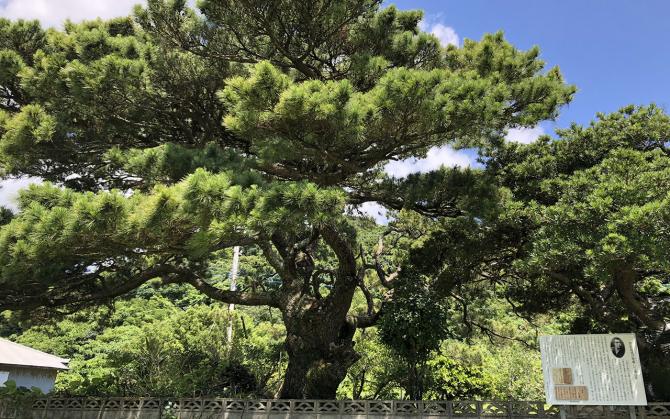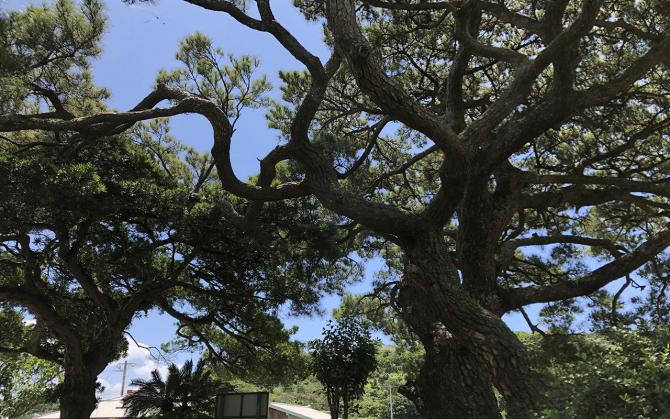ここから本文です。
Saigo Takamori Okuyama House and Pine Tree
Beneath this ancient pine tree in the mid-nineteenth century, one of history’s most famous samurai contemplated the future of his nation while awaiting the ship that would transport him into exile on a remote island.
Patriot rebel
Saigo Takamori (1828–1877) led a turbulent life in the treacherous feudal politics of the time. He had served as a trusted local administrator, but he had also engaged in activities that posed a threat to the ruling Tokugawa shogunate.
Born into a low-ranking samurai family in Satsuma (Kagoshima), the young Saigo was sent as an envoy to Edo (Tokyo). But he was forced to return to Satsuma, and due to factional politics, he was arrested and exiled to Amami Oshima.
Throughout his life he argued passionately for his beliefs, which included everything from the resignation of the shogun, to relations with Korea, to the breaking up of feudal landholdings. His convictions often led to clashes with his superiors and in 1862 he was arrested again and sentenced to exile on Tokunoshima, then to the more remote island of Okinoerabu, south of the Amami Islands.
 While awaiting the ship to Okinoerabu, the authorities placed Saigo under a samurai supervisor at the Okuyama family home. He spent 17 days here, much of it in the Okuyama garden under the large pine tree, pondering his vision for the nation. The tree became known as the koshikake-matsu, literally “seat pine.” The house was a repository for historical documents, including records of the local population made for the Satsuma rulers and details of the Okuyama ancestral line. These have since been donated to the town and put on display.
While awaiting the ship to Okinoerabu, the authorities placed Saigo under a samurai supervisor at the Okuyama family home. He spent 17 days here, much of it in the Okuyama garden under the large pine tree, pondering his vision for the nation. The tree became known as the koshikake-matsu, literally “seat pine.” The house was a repository for historical documents, including records of the local population made for the Satsuma rulers and details of the Okuyama ancestral line. These have since been donated to the town and put on display.
Formidable figure
 Saigo’s stay at the Okuyama house may have been brief, but he made a strong impression on the islanders. A man of imposing size compared with his countrymen, and with a powerful jaw, he stood 180 centimeters tall. He shared his vision for a better Japan, through such declarations as, “Public servants must be righteous. Only then can they lead the people,” and, “I will give everything I have for the nation, so I beg you also to grit your teeth and do your best.”
Saigo’s stay at the Okuyama house may have been brief, but he made a strong impression on the islanders. A man of imposing size compared with his countrymen, and with a powerful jaw, he stood 180 centimeters tall. He shared his vision for a better Japan, through such declarations as, “Public servants must be righteous. Only then can they lead the people,” and, “I will give everything I have for the nation, so I beg you also to grit your teeth and do your best.”
Saigo was pardoned in 1864 and became a central player in the Meiji Restoration of 1868, which reinstated the emperor and altered the course of Japanese history. Although he was a senior figure in the new regime, he resigned over what he considered excessive westernization and other issues and returned to Satsuma.
In 1877 he led an unsuccessful rebellion against the government and, after being shot twice, died at his own hand. His life story loosely inspired the 2003 Hollywood film The Last Samurai.
※A museum charting the life and career of this local hero is planned for a site adjacent to the statue.
Getting there
- The Saigo Takamori Okuyama House and Pine Tree is 30-minutes’ drive from the airport and 15 minutes from Kametoku New Port.
お問い合わせ
より良いウェブサイトにするためにみなさまのご意見をお聞かせください
- イベント・祭り
- 徳之島町観光パンフレット
- モデルコース
- 宿泊
- 特産品・おみやげ
- 歴史・伝統
- お問い合わせ
- 金見崎ソテツトンネルと金見崎展望所
- 畦プリンスビーチ海浜公園
- 金见崎苏铁树道和瞭望台
- 金見崎蘇鐵隧道與金見崎瞭望台
- 가나미자키 소철 터널과 가나미자키 전망소
- Kanamizaki Palm Tunnel and Lookout
- 第46代横綱朝潮太郎記念像
- Statue of 46th Sumo Grand Champion Asashio Taro
- 畦王子海滩海滨公园
- 畦王子海灘海濱公園
- 아제 프린스 비치 해변공원
- Aze Prince Beach Seaside Park
- 第46代横綱朝潮太郎記念雕像
- 제46대 요코즈나 아사시오 타로 기념상
- 西鄉隆盛 奧山家與松樹
- 사이고 다카모리 오쿠야마 가옥과 소나무
- Saigo Takamori Okuyama House and Pine Tree
- 西郷隆盛 奥山家と松の木
- 第46代横纲朝潮太郎雕像
- 西乡隆盛,奥山家和古松
